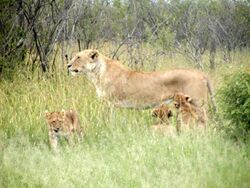Biology:Crèche (zoology)
The crèche (from French "daycare") in zoology refers to the care of offspring in a group or colony.[1][2] Many species such as common eiders,[1] lions,[2] and penguins[3] form crèches and exhibit group behaviours. Crèches can serve different functions and purposes depending on the species and the environment. For example, some crèches may aid in defence [2] while other crèches may aid in feeding and protection from harsh weather conditions.[3] This form of group living has evolved to become advantageous to the species. Studies have shown that by participating in group living, species will increase their inclusive fitness since their young will be in a better condition to reproduce and carry on the line of descendants in the species.[4]
Crèche behaviour in eiders, Somateria mollissima
In the Common eider population, after giving birth to their eggs, the mother will incubate them until they hatch.[1] The mothers will hear a signal from the juvenile's which will cause her to move away and open the nest for the eggs to hatch safely.[5] Once the eggs have hatched, the mother will either abandon her young, care for her young alone or join a multi-female crèche.[1] In the common eider species, if the crèche group behaviour is followed, the formation of the crèche will occur as soon as the juveniles leave the nest, and the group behaviour will last for a long period as the mother provides parental care to her young as they develop.[5] Studies have shown that while the parental care mode can change over the years, 46% of female eiders will care for their young through a multi-crèched environment.[1] Female eiders can care for their young through a true crèche or a transient crèche.[1] In a true crèche, the mother will choose a select group of females to live and care for her young with for a long period of time.[1] Contrastingly, in a transient crèche, the female and her young will not stay with the same group for a long duration and they will move through different crèches rather than stay with one permanent group.[1] These transient crèches will normally form about two weeks after the juveniles hatch so they have time to experience social interaction with their mother and siblings first.[6] The females and young in the true crèches showed a higher level of overall condition compared to the transient crèches.[1] Another study provided evidence that common eiders who do not join a crèche will maintain the best condition throughout development compared to those who did.[6]
Crèche behaviour in lions
Crèche behaviours will also develop in certain species of lions. For the first four to six weeks of development, mothers will care for their young on their own to make sure they are getting the proper care and nutrition.[7] Once they reach six weeks, female pride mate mothers will group to form a crèche.[2] Mothers will form this crèche with other mothers who have cubs of the same age cubs.[8] These crèches could range from two to nine mothers, but they average around four to five mothers.[2] Females and their young will remain together in these crèches until the young have reached about two years of age.[2] Studies show that mothers in crèches which involve three to four females may suffer from low food intake.[2] The main advantage of crèches in lion species is for defence.[2] The mothers in a crèche will work together to defend their cubs and protect them from nomadic male lions or any other predators that may approach the pride.[2] The greater number of females in the crèche, the greater rates of male takeovers.[2] Being a member of a crèche, provides safety from predators for the cubs and ensures that the mother will forage in a group size close to optimum.[2] Studies have proven that mothers keep their cubs in crèche formations to initiate highly stable care groups that will aid in defence.[2] While crèches are great for defence, they have a contrasting impact on food intake. If there are a very high number of cubs in a crèche compared to mothers, the cubs could become severely undernourished.[8] As well, female lions without cubs will avoid a crèche as they would experience a low rate of food intake in that group living arrangement.[8] Studies have also shown that living in a crèche environment does not guarantee increased access and retrieval of resources.[7] When lions are nursing, the cubs that are raised in a crèche do not have an advantage of gaining more milk than their conspecifics who do not live in a crèche.[7]
Crèche behaviour in penguins

The crèche group behaviour will also be seen in many species of penguins. This behaviour will occur when multiple adult penguins rear their chicks together in a group formation.[3] In the majority of penguin crèches there will be more chicks than adults.[9] The main advantage of the crèche formation in penguins is to aid in thermoregulation [9][10] but the formation also helps prevent predation and aggression.[3] While living in a crèche the penguin chicks will be reared in the presence of multiple adults and therefore will be protected from aggressive adults or predators.[3] The largest crèche formations are seen when weather conditions are harsh.[10] These harsh conditions normally include very low temperatures and high humidity, wind speeds and cloud cover.[9] During these times in particular, there will be increased contact between adults and chicks as they gather together to provide warmth to one another to aid in thermoregulation.[10]
References
- ↑ 1.0 1.1 1.2 1.3 1.4 1.5 1.6 1.7 1.8 Kilpi, Mikael; Öst, Markus; Lindström, Kai; Rita, Hannu (2001-09-01). "Female characteristics and parental care mode in the crèching system of eiders, Somateria mollissima" (in en). Animal Behaviour 62 (3): 527–534. doi:10.1006/anbe.2001.1784. ISSN 0003-3472. https://www.sciencedirect.com/science/article/pii/S0003347201917841.
- ↑ 2.00 2.01 2.02 2.03 2.04 2.05 2.06 2.07 2.08 2.09 2.10 2.11 Packer, Scheel & Pusey (1988–1989). "Why lions form groups: food is not enough". The American Naturalist 136: 1–19. doi:10.1086/285079. https://www.journals.uchicago.edu/doi/pdfplus/10.1086/285079.
- ↑ 3.0 3.1 3.2 3.3 3.4 Le Bohec, Céline; Gauthier-Clerc, Michel; Le Maho, Yvon (2005-09-01). "The adaptive significance of crèches in the king penguin" (in en). Animal Behaviour 70 (3): 527–538. doi:10.1016/j.anbehav.2004.11.012. ISSN 0003-3472. https://www.sciencedirect.com/science/article/pii/S0003347205001569.
- ↑ Pollard, Kimberly Anne (2009). "Causes and Consequences of Sociality: Time Allocation, Individuality, and the Evolution of Group Size in Mammals". University of California. ProQuest 250133832. https://www.proquest.com/docview/250133832.
- ↑ 5.0 5.1 Munro, Bédard, J., J. (1977-10-01). "Crèche Formation in the Common Eider". The Auk 94 (4): 759–771. doi:10.2307/4085272. https://academic.oup.com/auk/article/94/4/759/5205762?login=true.
- ↑ 6.0 6.1 Öst, Ydenberg, Lindström, Kilpi, Markus, Ron, Kai, Mikael (2003-06-07). "Body condition and the grouping behavior of brood-caring female common eiders (Somateria mollissima)". Behavioral Ecology and Sociobiology 54 (5): 451–457. doi:10.1007/s00265-003-0641-0. https://link.springer.com/article/10.1007/s00265-003-0641-0.
- ↑ 7.0 7.1 7.2 Pusey, Packer, Anne E., Craig (1994-12-01). "Non-offspring nursing in social carnivores: minimizing the costs". Behavioral Ecology 5 (4): 362–374. doi:10.1093/beheco/5.4.362. https://academic.oup.com/beheco/article-abstract/5/4/362/203711.
- ↑ 8.0 8.1 8.2 VanderWaal, Mosser, Packer, Kimberly L., Anna, Craig (2009-04-03). "Optimal group size, dispersal decisions and post-dispersal relationships in female African lions". Animal Behaviour 77 (4): 949–954. doi:10.1016/j.anbehav.2008.12.028. https://www.sciencedirect.com/science/article/pii/S000334720900044X.
- ↑ 9.0 9.1 9.2 Davis, Lloyd S. (2012-01-30). "Creching behaviour of Adelie penguin chicks (Pygoscelis adeliae)". New Zealand Journal of Zoology 9 (2): 279–285. doi:10.1080/03014223.1982.10423856.
- ↑ 10.0 10.1 10.2 Lawless, Buttemer, Astheimer, Kerry, R. M., W. A., L. B., K. R. (2001-11-01). "The influence of thermoregulatory demand on contact crèching behaviour in Adélie Penguin chicks". Journal of Thermal Biology 26 (6): 555–562. doi:10.1016/S0306-4565(00)00049-8. https://www.sciencedirect.com/science/article/pii/S0306456500000498.
 |



